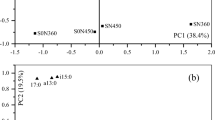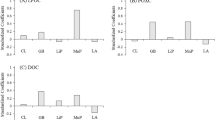Abstract
Regular input of organic matter under organic system of agriculture may bring about quantitative and qualitative changes in soil organic matter (SOM) and could impact microbial and biochemical properties of soil. While the effect of organic amendments on quantitative changes in soil organic C (SOC) is fairly well-documented, the relationship between physical fractions of SOM and microbial and biochemical activity of soils is relatively less quantified. Using an on-farm approach, we studied the effect of organic and conventional systems of agriculture on soil microbial and enzyme activities and microbial community composition in order to establish their relationship with physical fractions of SOC in rice-wheat sequence. Organic system of management improved SOC stocks by 2.2 Mg ha−1 in the top 15-cm soil, and the accrued C occurred as coarse particulate (cPOC) and mineral-associated organic C (MinOC). Organic production systems were characterised by higher microbial biomass C (MBC), mineralisable C, enzyme activities and population of bacteria, fungi and actinomycetes in soil than the conventional system of management. A regression model, which included dehydrogenase, cellulase, xylanase, MBC and clay, could predict differences in SOC between organic and conventionally managed fields, indicating the need for using several indicators together for characterising the two systems of management. Organic agriculture favourably impacted microbial and C-cycle enzyme activities, which regulated organic matter decomposition and stabilisation in soil.




Similar content being viewed by others
References
Adam G, Duncan H (2001) Development of a sensitive and rapid method for the measurement of total microbial activity using fluorescein diacetate (FDA) in a range of soils. Soil Biol Biochem 33:943–951
Alef K, Nannipieri P (1995) Methods in applied soil microbiology and biochemistry. Academic, San Diego
Allison SD, Jastrow JD (2006) Activities of extracellular enzymes in physically isolated fraction of restored grassland soils. Soil Biol Biochem 38:3245–3256
Atlas RM, Bartha R (1998) Microbial ecology: fundamental and application. Benjamin/Cummings Publishing Co, Menlo Park
Bandick A, Dick RP (1999) Field management effects on soil enzyme activities. Soil Biol Biochem 31:1471–1479
Benbi DK, Khosa MK (2014) Effect of temperature, moisture and chemical composition of organic substrates on C mineralization in soils. Commun Soil Sci Plant Anal. doi:10.1080/00103624.2014.950423
Benbi DK, Senapati N (2010) Soil aggregation and carbon and nitrogen stabilization in relation to residue and manure application in rice-wheat systems in northwest India. Nutr Cycl Agroecosyst 87:233–247
Benbi DK, Toor AS, Kumar S (2012) Management of organic amendments in rice-wheat cropping system determines the pool where carbon is sequestered. Plant Soil 360:145–162
Benbi DK, Brar K, Toor AS, Sharma S (2015) Sensitivity of labile soil organic carbon fractions to long-term fertilizer, straw and manure management in rice-wheat system. Pedosphere 25:534–545
Bird M, Santrùková H, Lloyd J, Lawson E (2002) The isotopic composition of soil organic carbon on a north–south transect in western Canada. Eur J Soil Sci 53:393–403
Bugg TDH, Ahmad M, Hardiman EM, Singh R (2011) The emerging role for bacteria in lignin degradation and bio-product formation. Curr Opin Biotechnol 22:394–400
Burns RG, DeForest JL, Marxsen J, Sinsabaugh RL, Stromberger ME, Wallenstein MD, Weintraub MN, Zoppini A (2013) Soil enzymes in a changing environment: current knowledge and future directions. Soil Biol Biochem 58:216–234
Caldwell BA (2005) Enzyme activities as a component of soil biodiversity: a review. Pedobiologia 49:637–644
Cambardella CA, Elliott ET (1992) Particulate soil organic-matter changes across a grassland cultivation sequence. Soil Sci Soc Am J 56:777–783
Cambardella CA, Elliott ET (1993) Methods for physical separation and characterization of soil organic matter fractions. Geoderma 56:449–457
Casida LE Jr, Klein DA, Santoro T (1964) Soil dehydrogenase activity. Soil Sci 98:371–376
Cheema HS, Singh B (1990) CPCS1—a computer program package for the analysis of commonly used experimental designs. Punjab Agricultural University, Ludhiana
Christensen BT (2001) Physical fractionation of soil and structural and functional complexity in organic matter turnover. Eur J Soil Sci 52:345–353
de Oliveira Freitas N, Yano-Melo AM, da Silva FSB, de Melo NF, Maia LC (2011) Soil biochemistry and microbial activity in vineyards under conventional and organic management at Northeast Brazil. Sci Agric (Piracicaba, Braz) 68:223–229
Dick RP (1994) Soil enzyme activities as indicators of soil quality. In: Defining soil quality for a sustainable environment. SSSA Special publication no. 35, Madison, WI, pp. 107–124
Dungait JAJ, Hopkins DW, Gregory A, Whitmore AP (2012) Soil organic matter turnover is governed by accessibility not recalcitrance. Glob Chang Biol 18:1781–1796
Elliott ET, Burke IC, Mong CA, Frey SD, Paustian KH, Collins HP, Paul EA, Cole CV, Blevins RL, Frey WW, Lyon DJ, Halvorson AD, Huggins DR, Turco RF, Hickman MV (1994) Terrestrial carbon pools in grassland and agricultural soil: preliminary data from the carbon belt and great plains regions. In: Doran V et al. (eds) Defining soil quality for a sustainable environment. SSSA Special publication no. 35, Madison, WI, pp 179–191
Federle TW, Ventullo RM, White DC (1990) Spatial distribution of microbial biomass, activity, community structure and the biodegradation of linear alkylbenzene sulfonate (LAS) and linear alcohol ethoxylate (LAE) in the subsurface. Microb Ecol 20:297–313
Garcia-Ruiz R, Ochoa V, Hinojosa MB, Carreira JA (2008) Suitability of enzyme-activities for the monitoring of soil quality improvement in organic-agricultural systems. Soil Biol Biochem 40:2137–2145
Gil-Sotres F, Trasar-Cepeda C, Leiros MC, Seoane S (2005) Different approaches to evaluating soil quality using biochemical properties. Soil Biol Biochem 37:877–887
Green VS, Stott DE, Diack M (2006) Assay for fluorescein diacetate hydrolytic activity: optimization for soil samples. Soil Biol Biochem 38:693–701
Gregorich EG, Janzen HH (1996) Storage of soil carbon in the light fraction and macro-organic matter. In: Carter MR, Stewart BA (eds) Structure and organic matter storage in agricultural soils. CRC Lewis Publishers, Boca Raton, pp 167–190
Haynes RJ (2005) Labile organic matter fractions as central components of the quality of agricultural soils. Adv Agron 85:221–268
IFOAM (1998) Basic standards for organic production and processing. In: International Federation of Organic Agricultural Movements, General Assembly, Argentina
Jackson ML (1967) Soil chemical analysis. Prentice Hall International Inc, London
Kandeler E, Luxhoi J, Tscherko D, Magid J (1999) Xylanase, invertase and protease at the soil-litter interface of a loamy sand. Soil Biol Biochem 31:1171–1179
Kaur P, Hundal SS (2008a) Climatic trends in different agroclimatic zones of Punjab. II. Rainfall features and its variability. J Res (Punjab Agric Univ) 45:41–50
Kaur P, Hundal SS (2008b) Climatic trends in different agroclimatic zones of Punjab. I. Temperature features and its variability. J Res (Punjab Agric Univ) 45:30–40
Kiss S, Dragan-Bularda M, Radulescu D (1975) Biological significance of enzymes in soil. Adv Agron 27:25–91
Ladd JN (1978) Origin and range of enzymes in soil. In: Burns RG (ed) Soil enzymes. Academic, New York, pp 51–80
Malhi SS, Nyborg M, Solberg ED, McConkey B, Dyck M, Puurveen D (2011) Long-term straw management and N fertilizer rate effects on quantity and quality of organic C and N and some chemical properties in two contrasting soils in western Canada. Biol Fertil Soils. doi:10.1007/s00374-011-0587-8
Marinari S, Liburdi K, Masciandaro G, Ceccanti B, Grego S (2007) Humification- mineralization pyrolytic indices and carbon fractions of soil under organic and conventional management in central Italy. Soil Tillage Res 92:10–17
Martens DA, Johanson JB, Frankenberger WT Jr (1992) Production and persistence of soil enzymes with repeated additions of organic residues. Soil Sci 153:53–61
Melero S, Porras JC, Herencia JF, Madejo E (2006) Chemical and biochemical properties in a silty loam soil under conventional and organic management. Soil Tillage Res 90:162–170
Miller GL (1959) Use of dinitrosalicylic acid reagent for determination of reducing sugars. Anal Chem 31:426–428
Moscatelli MC, Lagomarsino A, Garzillo AMV, Pignataro A, Grego S (2012) β-Glucosidase kinetic parameters as indicators of soil quality under conventional and organic cropping systems applying two analytical approaches. Ecol Indic 13:322–327
Nannipieri P, Ascher J, Ceccherini MT, Landi L, Pietramellara G, Renella G (2003) Microbial diversity and soil functions. Eur J Soil Sci 54:655–670
Naseby DC, Lynch JM (2002) Enzymes and microorganisms in the rhizosphere. In: Burns RG, Dick RP (eds) Enzymes in the environment: activity, ecology and applications. Marcel Dekker, New York, pp 109–123
Nieder R, Benbi DK (2008) Carbon and nitrogen in the terrestrial environment. Springer, Heidelberg
Pancholy SK, Rice EL (1973) Soil enzymes in relation to old field succession: amylase, cellulase, invertase, dehydrogenase and urease. Soil Sci Soc Am Proc 37:47–50
Pascual JA, Garcia C, Hernandez T (1998) Comparison of fresh and composted organic waste in their efficacy for the improvement of arid soil quality. Bioresour Technol 68:255–265
Powlson DS, Brookes PC, Christensen BT (1987) Measurement of soil microbial biomass provides an early indication of changes in total soil organic matter due to straw incorporation. Soil Biol Biochem 19:159–164
Rasmussen PE, Collins HP (1991) Long-term impacts of tillage, fertilizer, and crop residue on soil organic matter in temperate semiarid regions. Adv Agron 45:93–134
Rhee YH, Hah YC, Hong SW (1987) Relative contributions of fungi and bacteria to soil carboxymethylcellulase activity. Soil Biol Biochem 19:479–481
Schinner F, von Mersi W (1990) Xylanase, CM-cellulase and invertase activity in soil: an improved method. Soil Biol Biochem 22:511–515
Schnurer J, Rosswall T (1982) Fluorescein diacetate hydrolysis as a measure of total microbial activity in soil and litter. Appl Environ Microbiol 43:1256–1261
Sleutel S, Steefan DN, Nemeth T, Toth T, Hofman G (2005) Effect of manure and fertilizer application on the distribution of organic carbon in different soil fractions in long-term field experiments. Eur J Agron 25:280–288
Stemmer M, Gerzabek MH, Kandeler E (1998) Organic matter and enzyme activity in particle-size fractions of soils obtained after low-energy sonication. Soil Biol Biochem 30:9–17
Stemmer M, Gerzabek MH, Kandeler E (1999) Invertase and xylanase activity of bulk soil and particle-size fractions during maize straw decomposition. Soil Biol Biochem 31:9–18
Taylor JP, Wilson B, Mills MS, Burns RG (2002) Comparison of microbial numbers and enzymatic activities in surface soils and subsoils using various techniques. Soil Biol Biochem 34:387–401
Theuerl S, Buscot F (2010) Laccases: toward disentangling their diversity and functions in relation to soil organic matter cycling. Biol Fertil Soils 46:215–225
USDA (1999) Soil taxonomy: a basic system of soil classification for making and interpreting soil survey. Agriculture handbook 436. Soil Survey Staff, United States Department of Agriculture, Natural Resource Conservation Service, Washington, DC
Vance ED, Brookes PC, Jenkinson DS (1987) An extraction method for measuring soil microbial biomass C. Soil Biol Biochem 19:703–707
von Lützow M, Kögel-Knabner I, Ekschmitt K, Flessa H, Guggenberger G, Matzner E, Marschner B (2007) SOM fractionation methods: relevance to functional pools and stabilization mechanisms. Soil Biol Biochem 39:2183–2207
Wander MM, Traina SJ (1996) Organic matter fractions from organically and conventionally managed soils: I. Carbon and nitrogen distribution. Soil Sci Soc Am J 60:1081–1087
Yan D, Wang D, Yang L (2007) Long term effect of chemical fertilizer, straw and manure on labile organic matter fractions in a paddy soil. Biol Fertil Soils 44:93–101
Yu HY, Ding WX, Luo JF, Donnison A, Zhang JB (2012) Long-term effect of compost and inorganic fertilizer on activities of carbon-cycle enzymes in aggregates of an intensively cultivated sandy loam. Soil Use Manag 28:347–360
Acknowledgment
This research was supported by the Indian Council of Agricultural Research (ICAR) National Professor Project.
Author information
Authors and Affiliations
Corresponding author
Ethics declarations
Conflict of interest
The authors declare they have no conflict of interest.
Rights and permissions
About this article
Cite this article
Benbi, D.K., Sharma, S., Toor, A.S. et al. Differences in soil organic carbon pools and biological activity between organic and conventionally managed rice-wheat fields. Org. Agr. 8, 1–14 (2018). https://doi.org/10.1007/s13165-016-0168-0
Received:
Accepted:
Published:
Issue Date:
DOI: https://doi.org/10.1007/s13165-016-0168-0




